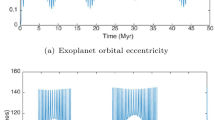Abstract
Lately, more and more exoplanets are being discovered and the number is expected to increase thanks to the excellent programs dedicated to this task. Thus it is important to study the dynamical behavior of planetary systems. Among all the problems that may be considered, we are interested in four-body planetary systems. In this article, we first examine the possible cases in four-body planetary systems including satellites, in both single and multiple stars. Step decomposition is a methodology explained by A. Abad and J.A. Docobo to deal with n-body problems with hierarchy. The use of this technique permits the reduction of the different cases to five configurations. The analytical integration of one of these cases, a double star with a planet and a satellite orbiting one of the components of the stellar system, is the objective. First the Hamiltonian of the problem is given and then we formulate it in terms of three small parameters which can be reduced to two in this case. After that, using Hori’s biparametric method, the dependence on the angular variables is removed, thereby allowing the integration of the problem.
Similar content being viewed by others
References
A. J. Abad, Publicaciones del Seminario Matemático García de Galdeano (Universidad de Zaragoza, Spain, 1984).
A. J. Abad and J. A. Docobo, Cel. Mech. 41, 333 (1988).
A. J. Abad and J. Ribera, Publicaciones del Seminario Matem ático García de Galdeano (Universidad de Zaragoza, Spain, 1984).
M. Andrade, Astron. J. 136, 1030 (2008).
K. Beuermann et al., Astron. Astrophys. 521, L60 (2010).
S. Chatterjee et al., Astrophys. J. 686, 580 (2008).
S. Desidera and M. Barbieri, Astron. Astrophys. 462, 345 (2007).
R. Dvorak, Mitteilungen. Astron. Gesellsch. 48, 87 (1980).
R. Dvorak, Oesterreich. Akad. Wissensch., Mathem.-Naturwissensch. Klasse, Sitzungsberichte, Abt. 2 191, 423 (1982).
R. Dvorak, Cel. Mech. 34, 369 (1984).
R. Dvorak, C. Froeschle, and Ch. Froeschle, Astron. Astrophys. 226, 335 (1989).
R. Dvorak, C. Froeschle, and Ch. Froeschle, Bull. Am. Astron. Soc. 18, 842 (1986).
R. Dvorak et al., Astrobiol. 10, 33 (2010).
R. Dvorak and Á. Süli, Cel. Mech. Dyn. Astr. 83, 77 (2002).
S. Ferraz-Mello, C. Beaugé, and T. A. Michtchenko,, in Proceedings of the Colloquium on 10th Anniversary of 51 Peg-b: Status of and Prospects for Iot Jupiter Studies, Observatoire de Haute Provence, France, August 22–25, 2005, Ed. by L. Arnold, F. Bouchy and C. Moutou (Frontier Group, Paris, 2006), p. 295.
S. Ferraz-Mello and T. A. Michtchenko, Rev. Mex. Astron. Astrophys. (Conf.) 14, 7 (2002).
B. Funk et al., Cel. Mech. Dyn. Astr. 90, 43 (2004).
B. Funk et al., Mon. Not. R. Astron. Soc. 410, 455 (2011).
N. Haghighipour, R. Dvorak, and E. Pilat-Lohinger, Astrophys. Space Sci. Lib. 366, 285 (2010).
B.M. S. Hansen, Astrophys. J. 723, 285 (2010).
R. S. Harrington, Astron. J. 82, 753 (1977).
R. S. Harrington, Bull. Am. Astron. Soc. 9, 435 (1977).
R. S. Harrington and B. J. Harrington, Mercury 7, 34 (1978).
R. Heller, J. Leconte, and R. Barnes, Astron. Astrophys. 528, A27 (2011).
M. J. Holman and P. A. Wiegert, Astron. J. 117, 621 (1999).
G. Hori, Publ. Astron. Soc. Jpn. 18, 287 (1966).
L. Kiseleva-Eggleton et al., Bull. Am. Astron. Soc. 34, 1144 (2002).
R. Kita, F. Rasio, and G. Takeda, Astrobiol. 10, 733 (2010).
R. K. Kopparapu and R. Barnes, Astrophys. J. 716, 1336 (2010).
T. A. Michtchenko, C. Beaugé, and S. Ferraz-Mello,, Cel. Mech. Dyn. Astr. 94, 411 (2006).
M. A. C. Perryman and T. Schulze-Hartung, Astron. Astrophys. 525, A65 (2011).
E. Pilat-Lohinger and R. Dvorak, Cel. Mech. Dyn. Astr. 82, 143 (2002).
E. Pilat-Lohinger, B. Funk, and R. Dvorak, Astron. Astrophys. 400, 1085 (2003).
G. Rabl and R. Dvorak, Astron. Astrophys. 191, 385 (1988).
C. Scharf and K. Menou, Astrophys. J. Lett. 693, L113 (2009).
J. Schneider et al., Astron. Astrophys. 532, A79 (2011).
R. Schwarz et al., Astron. Astrophys. 474, 1023 (2007).
V. Szebehely, Zeitschr. Angew. Math. Phys. 30, 364 (1979).
V. Szebehely, Cel. Mech. 22, 7 (1980).
V. Szebehely and R. McKenzie, Astron. J. 82, 79 (1977).
A. Tokovinin, in Highlights of Astronomy 13, 25th General Assembly of the IAU-2003, Sydney, Australia, July 13–26, 2003, Ed. by O. Engvold (Astronomical Soc. Pacific, 2005), p. 992.
A. L. Whipple and V. Szebehely, Cel. Mech. 32, 137 (1984).
Author information
Authors and Affiliations
Corresponding author
Additional information
The article is published in the original.
Rights and permissions
About this article
Cite this article
Campo, P.P., Docobo, J.A. Analytical study of a four-body configuration in exoplanet scenarios. Astron. Lett. 40, 737–748 (2014). https://doi.org/10.1134/S1063773714110012
Received:
Published:
Issue Date:
DOI: https://doi.org/10.1134/S1063773714110012




